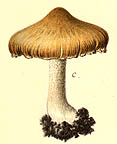 Key to Gilled Mushrooms Key
Key to Gilled Mushrooms KeyThis is a key to gilled mushrooms, that is, mushrooms having a definite cap with a fertile surface consisting of gills. The fruiting body usually also has a stem, although that may be lateral or absent (usually, then, the mushroom is growing from wood). You can use this key to identify mushrooms that you find.
 Agaricales Order
Agaricales OrderFruiting body containing fibers (usually in the stalk)
 Brown, Olive, Orange or Tan Spored Suborder
Brown, Olive, Orange or Tan Spored SuborderGills not free
Spore print tan, orange, deep ochre, yellowish olive, olive brown, rusty or cinnamon brown or deep brown
Ring usually either absent or not membranous
 Lignicolous Brown Spored Family
Lignicolous Brown Spored FamilyGrowing on wood
 Medium To Big Lignicolous Brown Spored Subfamily
Medium To Big Lignicolous Brown Spored SubfamilyCap usually more than 2" across, and sometimes up to 8; usually tan, yellow, or pumpkin-colored
 Pholiota Genus
Pholiota GenusHaving more than one of the following characters:
Cap slimy (all slimy MediumToBigLignicolousBrownSpored mushrooms go here)
Cap covered with pointy or fibrillose scales (all MediumToBigLignicolousBrownSpored mushrooms with this sort of scales go here)
Cap often yellowish
Scaly Pholiota Section

Diagnosis
- Growing on wood
-
Cap and stem with many pointy or patchy scales
-
Sometimes the scales wash off the cap in the rain (with a slippery cap, it's especially easy for that to happen); but they usually remain on the stalk (which is protected from the rain by the cap)
-
Cap typically yellowish
Narrow down your identification:
 Pholiota albocrenulata
Pholiota albocrenulataCap up to 4" across; slimy or viscid when fresh; very rounded at first, becoming umbonate; dark reddish brown or orange brown over the disk, shading to yellowish brown at the margin; often with small brownish scales especially towards the margin, which is also hung with scraps of veil tissue
Gills appearing fringed or uneven from the numerous cheilocystidia, and often beaded with tiny white droplets
Usually on deciduous wood, especially maple and elm
 Pholiota aurivella
Pholiota aurivellaCap up to 6" across; yellow; slimy when fresh, viscid when not; scales often flattened, spotlike, or patchy
Pholiota destruensCap up to 8" across; slimy when fresh; buff to brownish yellow
Universal veil white, cottony, thick; forming woolly or cottony patches on the cap, stem, and hanging from the cap margin; sometimes leaving a slight ring on the stalk
On cottonwood, aspen, poplar, and willow; especially emerging from the cut ends of logs
Pholiota flammansCap up to 4" across; viscid; yellow, with brighter yellow patches of universal veil material
Partial veil also leaving patches on lower stem below an evanescent annular zone
On coniferous wood
 Pholiota mutabilis
Pholiota mutabilisCap up to 2 1/4" across; glabrous; clearly hygrophanous; brown; often becoming umbonate
Partial veil leaving ring or annular zone, with the stalk covered with scaly veil remnants below it
Usually fruiting in dense clusters; often totally hiding the substrate
 Pholiota squarrosa
Pholiota squarrosaCap up to 5" across; yellow; not slimy
Cap and stem very scaly
Gills often with a greenish tinge
Odor often like onions or garlic
Usually in large clusters at the base of trees or stumps, especially aspen, birch, and spruce
Pholiota squarrosoidesCap up to 4" across; yellow; slimy in maturity in wet weather
Cap and stem very scaly
Gills white until colored by spores
Singly or in dense clusters on hardwoods, especially maple, alder, birch and beech






 Key to Gilled Mushrooms Key
Key to Gilled Mushrooms Key Agaricales Order
Agaricales Order Brown, Olive, Orange or Tan Spored Suborder
Brown, Olive, Orange or Tan Spored Suborder Medium To Big Lignicolous Brown Spored Subfamily
Medium To Big Lignicolous Brown Spored Subfamily Pholiota Genus
Pholiota Genus
 Pholiota aurivella
Pholiota aurivella Pholiota mutabilis
Pholiota mutabilis Pholiota squarrosa
Pholiota squarrosa




